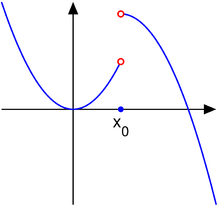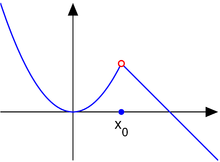Continuity is when a graph/function is predictable meaning you can tell where it's going. It is also where there are no breaks, no jumps, and no holes in the graph. A continuous graph can be drawn without lifting your pencil. Lastly, when the graph is approaching an infinite amount of x-values from the right and left, the graph meets at the same f(x), limit, and value meaning the limit equals the value.
(b) What is discontinuity?
 |
| JUMP |
 |
| POINT |
 |
| OSCILLATING (left) INFINITE (right) |
2. (a) What is a limit?
A limit is the intended height of a function. A limit is basically where the graph intends or plans to reach a point.
(b) When does a limit exist?
A limit exists when the graph is either continuous or inhibits point discontinuity. This is b/c the graph approaching an x-value from the right & left both meet at the same exact y-value.
(c) When does a limit not exist?
The limit does not exist in three cases. One: the graph approaching an x-value from the right & left do not reach the same y-value. Two: the graph inhibits a vertical asymptote which thus creates unbounded behavior. This means that the limit is +/- infinity which can't happen because +/- infinity isn't a number. Three: the graph exhibits oscillating behavior where the graph doesn't concentrate or approach on a single point (the wiggles are too intense!).
(d) What is the difference between a limit and a value?
A limit is the intended height while a value is the actual height. If the value is undefined at one point, the limit may or may not exist depending on if the graph approaches that point from the left and right. If a limit does not exist, the value may still exist if there is a plotted, closed-hole point that is present above or below the open-hole.
3. How do we evaluate limits numerically, graphically, and algebraically?
Numerically: we need to set up an x|y table to show as x approaches a # (in decimals!) from the left and right (-/+). For example, if we want to approach 2, we'd write {1.9, 1.99, 1.999, 2, 2.001, 2.01, 2.1}. We fill out the y column by punching in the #s on our graphing calculator! Graphically: we take our left index finger and stick it on the left side of the graph, then we take our right index finger and stick it on the right side of the graph and then start moving both fingers toward the ends of the graph. If our fingers meet, the limit exists at that y-value! If they do not meet, then the limit does not exist!!! (wow) Algebraically: There are four methods that come one after another. The first and easiest is direct substitution in which we plug the # x is approaching into the function. You can get four types of answers: a #, 0/# = 0, #/0 = ø, and lastly 0/0 = indeterminate form/not yet determined. If we get 0/0 there are three ways to solve it out: the dividing out/factoring method, the rationalizing/conjugate method, and solving limits at infinity. The dividing out/factoring method applies mostly to polynomials that you can factor out, then cancel something equal to 1, and use direct substitution. If there are no polynomials but instead radicals, we use rationalizing/conjugate method. We take the conjugate of the numerator/denominator WITH the radical (the conjugate is the change of the plus/minus sign to the opposite)and take this so to multiply it to the numerator & denominator giving us something to cancel and again use direct substitution. The last method is used only for limits at infinity confirming the presence of a horizontal asymptote. The easy way to solve these is to remember the use of the degree (exponent). If the degree was Bigger on Bottom, the y value was 0, or if it was the same then it'd be the ratio of the coefficients, and if it was Bigger on Top it'd be undefined and the limit wouldn't exist b/c of unbounded behavior. The long way is by dividing every term in the numerator and denominator by the highest power of x in the denominator and then using direct substitution. (note: #/infinity = 0)
TY FOR READIN' & HAVE A GOOD NIGHT!

No comments:
Post a Comment